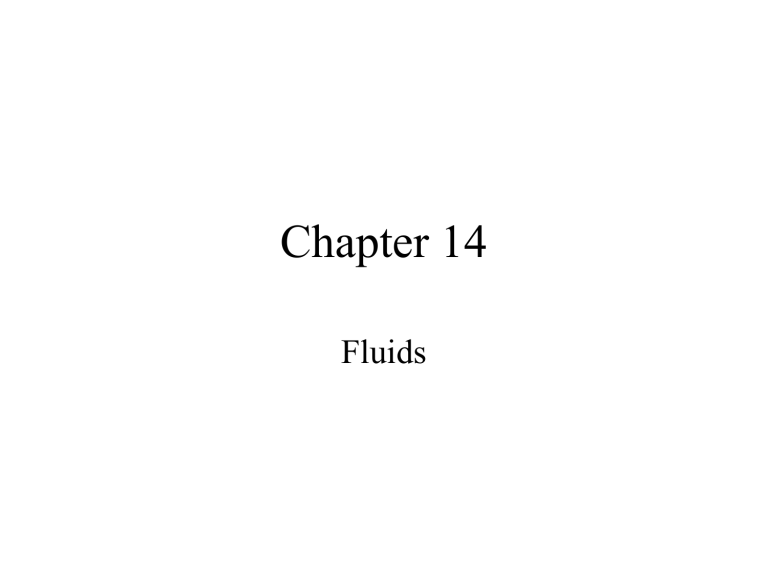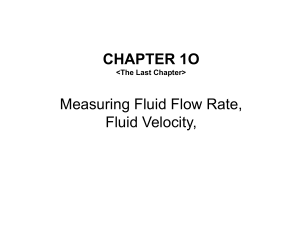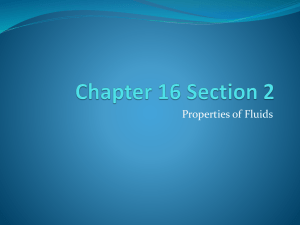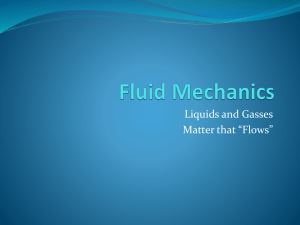Ch. 14

Chapter 14
Fluids
Fluids at Rest
(Fluid = liquid or gas)
Density (
r
)
r dm dV
• unit: kg/m 3
• we will consider only r
= m / V = constant
• (incompressible fluid)
• we will also assume g = constant
Pressure (
p
)
• A fluid exerts a force dF normal to any area dA you consider in it.
• For a fluid at rest, the force is equal and opposite on each side.
Pressure (
p
)
• Why is there a force?
• Microscopically: the fluid particles are in motion and collide with dA
• Macroscopically: the fluid is at rest
Pressure (
p
)
p
dF
dA
• pressure p is a scalar
(no intrinsic direction)
• reason: it acts normal to any surface dA
Pressure (
p
)
p
dF
dA
• units used: pascal, millibar, atm
• 1 Pa = 1 N/m 2
1 millibar = 100 Pa
1 atm = 1.013×10 5 Pa
Terminology
• ‘gauge pressure’ = p
– p atm
• (can be > 0 or < 0)
• (e.g., read on a car tire pressure gauge)
• p = absolute pressure (> 0)
= atmospheric pressure + gauge pressure
= p atm
+ gauge pressure
Pressure and depth
• pressure: p coordinate: y
• pressure decreases with ‘elevation’ y : dp
r g dy
Derive this result and integrate it
Pressure and depth
• coordinate: y distance: h > 0
• p increases with depth for any shape of vessel p
2
p
1
r g ( y
2
y
1
) p
1
p
2
r gh
Demonstration: depth and shape of container
Exercise 14-10
• The dangers of a long snorkel tube:
• Find the gauge pressure at the depth shown. Will this cause the snorkeler’s lungs to collapse?
Demonstration: atmospheric pressure
Pascal’s Law
• If any change in pressure
D p is applied at one point, it is transmitted to all points in the fluid and to walls enclosing it.
p
2
p
1
r g ( y
2
y
1
) p
1
p
2
r gh
Example: Hydraulic Lift
At equilibrium, p = F
1
/ A
1
= F
2
/ A
2
Demonstration
Two Pressure Gauges
Notes on (b) first Notes on (a) and Exercise 14-9
Homework Hints:
Exercise 14-55
Buoyancy and Buoyant Force
A (fully or partially) submerged object feels an upward force equal to the weight of fluid it displaces
(a) fluid element with weight w fluid
(b) body of same shape feels buoyant force B = w fluid
Demonstration
Surface Tension
• Molecules of liquid attract each other (else no definite volume)
• center: net force = 0
• surface: net force is directed inward
Surface Tension
• So the surface acts like a membrane under tension (like a stretched drumhead)
• The surface resists any change in surface area
• Strength characterized by ‘surface tension’
Demonstration
•
Surface Tension
g g
= F / d
= cohesive force per unit length
• surface tension force
F = g d
• We can measure g by just balancing F
Notes on measuring g
Do Example 14-23
cohesion: attraction of like molecules example: liquid-liquid forces (surface tension)
adhesion: attraction between unlike molecules example: liquid-glass forces
(a) adhesion > cohesion: water wets glass
(b) adhesion < cohesion: mercury beads up
Capillarity
• For these two cases, the surface tension force F pushes the column of liquid either up or down:
• (a) up for water
• (b) down for mercury
Notes on capillary tubes
Homework Announcements
• Homework Set 5: Correction to hints for
14-55 (handout at front and on webpage)
• Recent changes to classweb access
(see HW 5 sheet at front and webpage)
• Homework Sets 1, 2, 3: returned at front
(scores to be entered on classweb soon)
Midterm Announcements
• Friday:
• review required topics
• practice problems (from class, HW, new?)
• Monday: (midterm)
• you can bring a sheet of notes (both sides)
• you will be given a list of equations
Fluid Flow
(Fluid Dynamics)
Flow Fluid
• Flow line = path of fluid element
•
Flow tube = bundle of flow lines passing through area A
(just a useful construct)
Simplifying Assumptions
• Steady flow:
• At any given point in the fluid, its properties
( v , r
, p
) don’t change in time
Simplifying Assumptions
• Steady flow:
• different flow lines never cross each other
• fluid entering a flow tube never leaves it
Simplifying Assumptions
•
• Incompressible fluid: r
= constant
•
No friciton:
• no ‘viscosity’
Notes
Continuity Equation
A
1 v
1
= A
2 v
2
• the same volume dV of fluid enters and exits tube:
• dV = volume passing through A in dt
= Av dt dV
Av dt
Continuity Equation
A
1 v
1
= A
2 v
2
• along the flow:
•
A = area of flow tube v = speed of fluid
• if one increases, the other must decrease
Notes and Demonstration: water flow
Continuity Equation
A
1 v
1
= A
2 v
2
• Where the flow lines are crowding together, the fluid speed is increasing
Notes
Bernoulli’s Equation p
1
r gy
1
1
2 r v
1
2
p
2
r gy
2
1
2 r v
2
2
• only valid for: steady flow, incompressible fluid, no viscosity!
Bernoulli’s Equation p
1
r gy
1
1
2 r v
1
2
p
2
r gy
2
1
2 r v
2
2
• if v
1
= v
2
= 0:
• reduces to previous result for fluid at rest
Bernoulli’s Equation p
1
r gy
1
1
2 r v
1
2
p
2
r gy
2
1
2 r v
2
2
• if y
1
= y
2 then for p and v :
• if one increases, the other must decrease
Demonstration
Applications of
Bernoulli’s Equation
Notes
Venturi Meter (Example 14-10) horizontal flow tube
Note: if viscosity is present, then v decreases with distance from tube center
Notes
Venturi Meter:
Homework Problem 14-90 (c)
Demonstration
Wing Lift
Can’t predict flow lines but they indicate low pressure above wing, so net force up
Demonstration: propellor
Notes
Efflux Speed: vertical flow tube
Siphon: flow tube points up, then down
• First: you must fill the tube
• There is a limit:
H + h < 10 m
Warm-up demonstrations
Curve Ball: viscosity makes it possible
Viscosity drags air with spinning ball: low pressure=net force so the ball curves
Demonstration
Homework Announcements
• Homework Set 5: Correction to hints for
14-55 (handout at front and on webpage)
• Recent changes to classweb access
(see HW 5 sheet at front and webpage)
• Homework Sets 1, 2, 3: returned at front
(scores to be entered on classweb soon)





